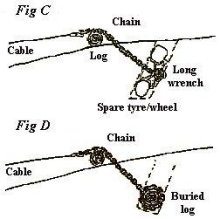
Please note that a proper 4x4 Advanced Recovery course, (Landrover School/Continental Academy), is recommended before attempting this yourself.
Owing to the potential risk to human life or damage to property, we have included a list of rules that should strictly be adhered to under any circumstances. Print out the list, laminate it and keep in a safe place in your 4x4!
There can only be one person in charge of a winching operation. This is not a democracy. The person with the most experience becomes the winch leader.
When winching, try to unspool as much of the cable as possible. Leaving too many cable winds on the drum, before winching, can actually cause the top layers of the cable, to damage the bottom layers. If the distance between the vehicle and the anchor point (or the stuck vehicle and the recovery vehicle) is too short, use a snatch block to half the distance.
Snatch blocks will allow you to double the effective pulling power of the winch. If need be, connect a snatch block with a D-shackle to a tree-trunk protector and loop back the cable to the vehicle itself.
The winch's effective pulling power decreases with each successive layer on the drum. Thus, the first layer of cable on the drum, will also be the most powerful pulling strength. However, never winch with less than 5 wraps of cable around the drum. Cable failure may result otherwise.
Re-engage
Always ensure the cable is reeling in as straight as possible. If necessary stops the operation, unwind some cable, and re-engage the winch, to ensure the cable is spooling around the drum evenly and tightly. Remember, the top cable layers will otherwise be drawn into the bottom layers and create a bind.
Put a blanket, jacket or heavy sack on the middle of the cable to ensure that if it should snap, it would act as a "parachute" to slow down the recoiling cable. Some 4x4 drivers actually raise the bonnet as well, to protect the windscreen in the event of cable failure.
Ensure that you know the maximum load rating of your winch. Never exceed this rating. Once again, use a snatch block to reduce the load on the winch if necessary, by almost 50%.
Never allow the cable to slide through your hands and use the switch to take up cable slack intermittently, to avoid shock loads on the drum and cable.
When a recovery vehicle is used to extract a stuck vehicle, ensure that the handbrake is up and the wheels are properly blocked with stones or rocks. The gearbox should be in neutral and the normal foot brake may be used to assist in anchoring the vehicle.
When winching, the stuck vehicle may assist itself by selecting an appropriate gear (low range, third). Ensure that the vehicle does not overtake the winch cable, as this would allow slack cable to be reeled in onto the drum or the vehicle's wheels to pass over the cable.
When the winch hook is within 1.5 meters of the drum/fairlead, release the remote control switch and stop the winch. At this point in time, intermittent, small uptakes may be used to get the hook in all the way. Do not over tighten the cable and always keep your hands clear!
Always ensure that the cable is inspected after use. If any fraying or damage has occurred, do not hesitate to replace the entire cable.
Sometimes it may be necessary to re-spool the cable with zero load on it. The correct method to use is to hold the remote in your one hand and the winch cable in the other and to start as far away from the vehicle as your remote control would allow you.
Start the winch with the remote and walk the cable in towards the drum for a meter or two. Now stop the remote and repeat the entire procedure. Remember to always stop the process when you are within 1.5 meters from the fairlead.
Adhering to the above rules should provide you with necessary basics of safe winching. However, as noted before, there is no substitute for actually experience gained, in an advanced recovery course, as recommended in the beginning.
When doing a winch recovery, a handy tree or rock might not always be available. Under these circumstances, a constructed anchor might be necessary.
This might be as diverse as a spare tyre, a log or a boat anchor! We have included some diagrams above to illustrate this more effectively.
In conclusion, remember to stick to well known brand names, such as Ramsey or Warn. Ensure that the load rating is sufficient for your vehicle, familiarise yourself with your equipment before setting out on the trail and treat the environment with respect.
Happy Recoveries!




 Publications
Publications
 Partners
Partners










